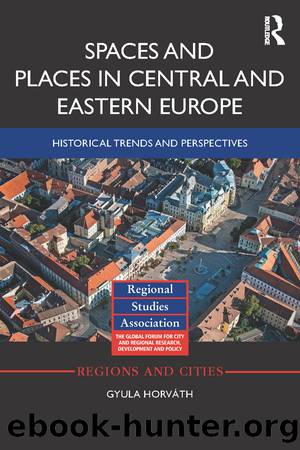Spaces and Places in Central and Eastern Europe by Horváth Gyula;Horváth Gyula;

Author:Horváth, Gyula;Horváth, Gyula;
Language: eng
Format: epub
ISBN: 1770539
Publisher: Taylor & Francis Group
6
Regional transformation and fragmentation in Russia
Spatial aspects of the power structure and economic development of the Soviet Union
Core regions in the Russian and Soviet empires
There was a breakthrough in the development of Russia the years of the late nineteenth and early twentieth centuries. A dynamic transformation took place in the Russian economy, although the prospects of achieving West European development levels seemed unrealistic. The moderate, (even, in some cases, more striking) signs of modernisation disguise the basic fact that Russia still remained a traditional society even at the beginning of the twentieth century and following a significant period of modernisation which involved radical change. The more modern they wished to make the country, the more underdeveloped became, and the adoption of Western patterns served the conservation of Eastern structures (Dixon 1999). One cause of the current underdevelopment of Russia is that market-determined development failed to bring the country closer to the West. Also in Russia, the modern state aimed from the outset at influencing development and counterbalancing market weaknesses. Support for this argument can be found in the writings of Alexander Gerschenkron who stated that, in Europe, competitive industrialisation simply increased the pressure on backward countries: on one hand it created ideologies of modernisation and industrialisation (including various versions of state Marxism) and on the other hand it also forced states and governments to support the development of national economies with their own resources (Gerschenkron 1962, 1970).
One of the visible signs of the underdevelopment of the country was the extremely high level of spatial differentiation. If we examine the economy, infrastructure, settlement network or the educational level of the population, the differences between European and Asian areas were huge. In the last decade of the nineteenth century the most developed industrial areas of the empire were the provinces of Moscow, Warsaw, Vladimir and St Petersburg. In these locations, industrial employment per thousand inhabitants was between 32 and 82 persons, while in the least developed areas it was between 1 and 7. According to data from 1892, 1.09 million people (1.2 per cent of the total population of 89.15 million in European Russia) worked in manufacturing and mining.
In the first decade of the twentieth century, industrial production data of the major regions showed 10â12 fold differences. At the beginning of the twentieth century, the production value of the manufacturing industry averaged 31 roubles for Russia as a whole, but 87 roubles for the Northwest regions and Baltic areas, 78 roubles for the Central Russian industrial area and a mere eight roubles for Asiatic Russia. In 1940, the spatial disparities in industry were even more significant. The per capita industrial production of the individual republics of then Soviet Union was 923 roubles in the Russian Federation and 71 roubles in Tajikistan. The differences in the industrial production indicators between the most and least developed areas increased from 11- to 13-fold during this 30-year period (Westlund et al. 2000). The favourable position of the Russian territories is clearly outlined by investment data: Russia was the clear beneficiary of Soviet investment policy for over 50years.
Download
This site does not store any files on its server. We only index and link to content provided by other sites. Please contact the content providers to delete copyright contents if any and email us, we'll remove relevant links or contents immediately.
International Integration of the Brazilian Economy by Elias C. Grivoyannis(57522)
The Radium Girls by Kate Moore(10965)
Turbulence by E. J. Noyes(7105)
Nudge - Improving Decisions about Health, Wealth, and Happiness by Thaler Sunstein(6684)
The Black Swan by Nassim Nicholas Taleb(6258)
Pioneering Portfolio Management by David F. Swensen(5645)
Rich Dad Poor Dad by Robert T. Kiyosaki(5210)
Zero to One by Peter Thiel(4884)
Man-made Catastrophes and Risk Information Concealment by Dmitry Chernov & Didier Sornette(4799)
Secrecy World by Jake Bernstein(3827)
Millionaire: The Philanderer, Gambler, and Duelist Who Invented Modern Finance by Janet Gleeson(3612)
Skin in the Game by Nassim Nicholas Taleb(3513)
The Age of Surveillance Capitalism by Shoshana Zuboff(3465)
The Money Culture by Michael Lewis(3321)
Skin in the Game: Hidden Asymmetries in Daily Life by Nassim Nicholas Taleb(3302)
Bullshit Jobs by David Graeber(3231)
The Dhandho Investor by Mohnish Pabrai(3198)
The Wisdom of Finance by Mihir Desai(3117)
Blockchain Basics by Daniel Drescher(2928)
